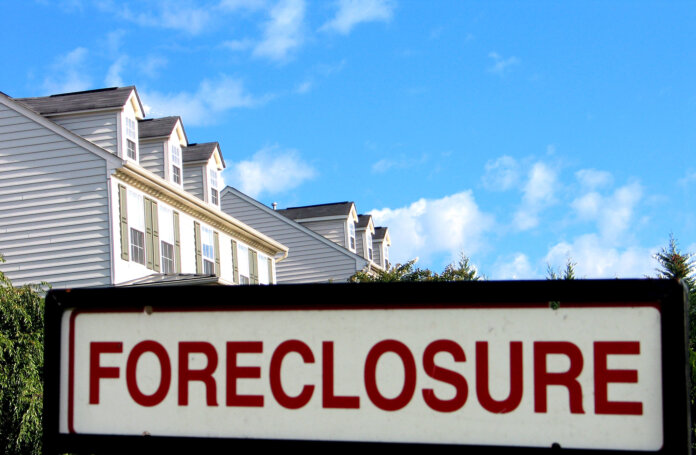ATTOM’s Year-End 2022 U.S. Foreclosure Market Report shows foreclosure filings – default notices, scheduled auctions and bank repossessions – were reported on 324,237 U.S. properties in 2022, up 115% from 2021 but down 34% from 2019, before the pandemic shook up the market.
Foreclosure filings in 2022 were also down 89% from a peak of nearly 2.9 million in 2010.
Those 324,237 properties with foreclosure filings in 2022 represented 0.23% of all U.S. housing units, up slightly from 0.11% in 2021, but down from 0.36% in 2019 and down from a peak of 2.23% in 2010.
“Eighteen months after the end of the government’s foreclosure moratorium, and with less than five percent of the 8.4 million borrowers who entered the CARES Act forbearance program remaining, foreclosure activity remains significantly lower than it was prior to the COVID-19 pandemic,” says Rick Sharga, executive vice president of market intelligence at ATTOM. “It seems clear that government and mortgage industry efforts during the pandemic, coupled with a strong economy, have helped prevent millions of unnecessary foreclosures.”
The report also includes new data for December 2022, showing there were 30,822 U.S. properties with foreclosure filings, up less than 1% from the previous month but up 72% from a year ago.
Lenders repossessed 42,854 properties through foreclosures (REO) in 2022, up 67% from 2021 but down 70% from 2019 (143,955) and down 96% from a peak of 1,050,500 in 2010.
States that saw the greatest number of REOs in 2022 included Illinois (5,518 REOs); Michigan (3,669 REOs); Pennsylvania (2,741 REOs); New York (2,405 REOs); and California (2,223 REOs).
Those metropolitan statistical areas with a population greater than 1 million that saw the greatest number of REOs in 2022 included Chicago, Ill. (3,545 REOs); Detroit, Ill. (2,135 REOs); New York, N.Y. (1,656 REOs); St. Louis, Mo. (1,395 REOs); and Philadelphia, Pa. (1,302 REOs).
“Unlike foreclosure activity during the Great Recession, the majority of homes in foreclosure are not being repossessed by lenders,” Sharga notes. “Our recent homeowner equity report shows that 93 percent of borrowers in foreclosure today have positive equity, which they appear to be leveraging in order to avoid a foreclosure by refinancing their mortgage or selling the property at a profit. It seems likely that this is a trend that will continue in 2023.”
Lenders started the foreclosure process on 248,170 U.S. properties in 2022, up 169% from 2021 but down 26% form 2019 and down 88% from a peak of 2,139,005 in 2009.
States that saw the greatest number of foreclosure starts in 2022 included California (27,269 foreclosure starts); Texas (23,151 foreclosure starts); Florida (22,968 foreclosure starts); Illinois (16,941 foreclosure starts); and Ohio (13,469 foreclosure starts);
Counter to the national trend, five states saw an increase in foreclosure starts from 2019. They included Indiana (up 81%); Michigan (up 10%); Idaho (up 8%); Colorado (up 2%); and Minnesota (up less than 1%).
Those metropolitan statistical areas with a population greater than 1 million that saw the greatest number of foreclosure starts in 2022, included New York, N.Y. (15,821 foreclosure starts); Chicago, Ill. (14,360 foreclosure starts); Los Angeles, Calif. (8,185 foreclosure starts); Philadelphia, Pa. (7,286 foreclosure starts); and Miami, Fla. (7,090 foreclosure starts).
States with the highest foreclosure rates in 2022 were Illinois (0.49% of housing units with a foreclosure filing); New Jersey (0.45%); Delaware (0.40%); Ohio (0.38%); and South Carolina (0.37%).
Rounding out the top 10 states with the highest foreclosure rates in 2022, were Nevada (0.34%); Florida (0.33%); Indiana (0.30%); Maryland (0.27%); and Michigan (0.26%).
Among 223 metropolitan statistical areas with a population of at least 200,000, those with the highest foreclosure rates in 2022 were Cleveland, Ohio (0.70% of housing units with a foreclosure filing); Jacksonville, N.C. (0.58%); Atlantic City, N.J. (0.58%); Columbia, S.C. (0.55%); and Chicago, Ill. (0.53%).
Metro areas with a population greater than 1 million, including Cleveland, Ohio and Chicago, Ill., that had the highest foreclosure rates in 2022, were Philadelphia, Pa. (0.43%); Las Vegas, Nev. (0.42%); and Jacksonville, Fla. (0.42%).
U.S. properties foreclosed in the fourth quarter of 2022 had been in the foreclosure process an average of 852 days, a 4% decrease from the previous quarter and 9% decrease from a year ago.
States with the longest average time to foreclose in Q4 2022 were Hawaii (2,546 days); New Jersey (2,041 days); Louisiana (1,925 days); New York (1,828 days); and Pennsylvania (1,692 days).
There was a total of 90,715 U.S. properties with foreclosure filings in Q4 2022, down % from the previous quarter but up 61% from a year ago.
Nationwide in Q4 2022, one in every 1,549 properties had a foreclosure filing. States with the highest foreclosure rates in Q4 2022 were Illinois (one in every 724 housing units with a foreclosure filing); Delaware (one in every 848 housing units); New Jersey (one in every 860 housing units); South Carolina (one in every 950 housing units); and Ohio (one in every 1,035 housing units).
Nationwide in December 2022, one in every 4,558 properties had a foreclosure filing. States with the highest foreclosure rates in December 2022 were South Carolina (one in every 2,301 housing units with a foreclosure filing); New Jersey (one in every 2,378 housing units); Illinois (one in every 2,399 housing units); Delaware (one in every 2,535 housing units); and Ohio (one in every 3,027 housing units).
In December 2022, 21,023 U.S. properties started the foreclosure process, up 2% from the previous month and up 129% from a year ago. Lenders completed the foreclosure process on 3,663 U.S. properties in December 2022, down 3% from the previous month but up 21% from a year ago.
Image: “Foreclosure” by taberandrew is licensed under CC BY 2.0 .














